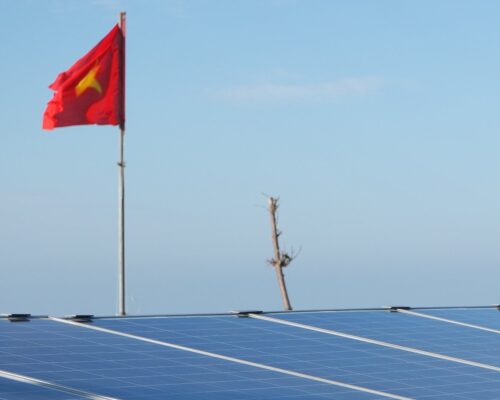What Does an Ambitious Clean Energy Target Mean for Bangladesh?
Photo: Shutterstock/Salvacampillo
19 April 2023 – by Shafiqul Alam
Bangladesh intensified its greenhouse gas (GHG) mitigation ambitions in the buildup to the 27th Conference of the Parties (COP27). It raised its targets for unconditional and conditional GHG emissions mitigation to 6.73% and 15.12%, respectively, from the previous 5% and 10% by 2030 in the selected sectors, compared to business-as-usual (BAU) scenarios. In addition, the country is currently developing an Integrated Energy and Power Master Plan (IEPMP), which is likely to boost the country’s clean energy generation capacity target to 40% by 2041. Since the power and energy sectors account for around 76% of the GHG emissions covered in the Nationally Determined Contributions (NDCs), enhanced renewable energy capacity could help Bangladesh surpass the GHG mitigation targets.
While Bangladesh’s existing power system can incorporate a significant amount of renewable energy, the country needs to invest steadily in clean energy to reach the 40% generation capacity goal. The economic competitiveness of renewable energy also makes it a favourable choice in the future.
Existing Power System Can Accommodate a Good Amount of Renewable Energy
Renewable energy is gaining traction in the country, albeit slower than the pace necessary to take advantage of its cost-competitiveness at scale. Of the 310.43 million kilowatt-hour (MkWh) of grid energy consumed on 16 April 2023 in the country, according to the daily generation archive, renewable energy contributed to roughly 3.2MkWh.
A recent Institute for Energy Economics and Financial Analysis (IEEFA) study, based on the assessment of Bangladesh’s energy curves from March 2022 to February 2023, shows that although oil-fired plants should serve peak demand, Bangladesh used them extensively throughout the year.
The study concludes that Bangladesh could accommodate 1.7 gigawatts (GW) to 3.4GW of solar energy within the existing power system capacity to replace oil-fired plants when sunlight is available, thus driving down the average power generation cost.
Likewise, Bangladesh could reduce the operation of oil-fired plants at night by up to 4GW, contingent upon the feasibility of wind power.
Economics Favours the Integration of More Renewable Energy in the Future
Bangladesh’s average grid-based power generation cost rose to Bangladeshi Taka (Tk) 8.84/kilowatt-hour (kWh) (US$0.083/kWh) in fiscal year (FY) FY2021-22, a 33.7% increase from FY2020-21. As the gas price for power generation has increased and expensive coal fires the coal-based plants, the average power generation cost would rise further.
Even as the Bangladesh government has been chalking out plans to reduce the subsidy burden of the power and energy sectors, the country is heading to an expensive energy cost regime with frequent energy price hikes. Of course, consumers will shoulder much of the incremental cost.
Contrary to the rising cost trajectory of the country’s power system, which mostly runs on fossil fuels, renewable energy prices are falling. The levelised of cost of energy from utility-scale solar is already less in Bangladesh than its average power generation cost for FY2021-22. With the application of instruments, like auctions, in the foreseeable future, the cost of solar energy will likely fall in the country. Wind power will also become cheaper.
Therefore, Bangladesh should take the opportunity to build more renewable energy-based power plants to meet future electricity demand. Since Bangladesh would also need to incorporate energy storage systems in the future, it should keep an eye on the pricing trend of such systems.
Bangladesh Needs Consistent Investment to Attain the 40% Renewable Energy Target
The IEEFA study substantiates that Bangladesh must consistently invest up to US$1.71 billion annually from 2024 through 2041 to attain 40% renewable energy capacity.
Given that the subsidy burden of the power sector in FY2021-22 alone was US$2.82 billion, the investment in renewable energy would help gradually free up this subsidy payment, which the government could recycle in the power sector for rapid clean energy transition.
Notably, many upcoming renewable energy-based power plants will follow the independent power producer (IPP) model. As such, the private investors will bear much of the annual investment required for a 40% renewable energy goal. Even then, Bangladesh should have a clear map of the funding sources, i.e., local banks/financial institutions and international multilateral institutions/private investors, to visualise the road that the country would follow.
Among other channels, the Just Energy Transition Partnership (JETP) could be an option to receive cheap funding for clean energy promotion. The COP28, to be held later this year in Dubai, would be the platform for Bangladesh to place the proposal for a JETP fund.
While it is probably an ambitious venture for Bangladesh to hit 40% renewable energy by 2041, it is the most plausible option to expand renewable energy at scale to contain the rising power generation cost and limit dependence on international fossil fuel markets.
Bangladesh must be ready for the big push, flanked by a reflection of the policy vision in the annual work plan and the details of technical and financial needs. The first step would be to fix the 40% renewable energy target by 2041 in the IEPMP. Then, the country would need to change gears to move away from the BAU power sector development.
Shafiqul Alam is the IEEFA’s Energy Finance Analyst for Bangladesh. He has more than a decade of experience in the energy and climate change sectors. His interests primarily centre on renewable energy, energy efficiency, climate finance and policy instruments to spearhead the clean energy transition.
About the IEEFA
The IEEFA is an independent think tank that examines issues related to energy markets, trends and policies.
Disclaimer: The views and opinions expressed in this article are those of the author and do not necessarily reflect the official policy or position of Energy Tracker Asia.





